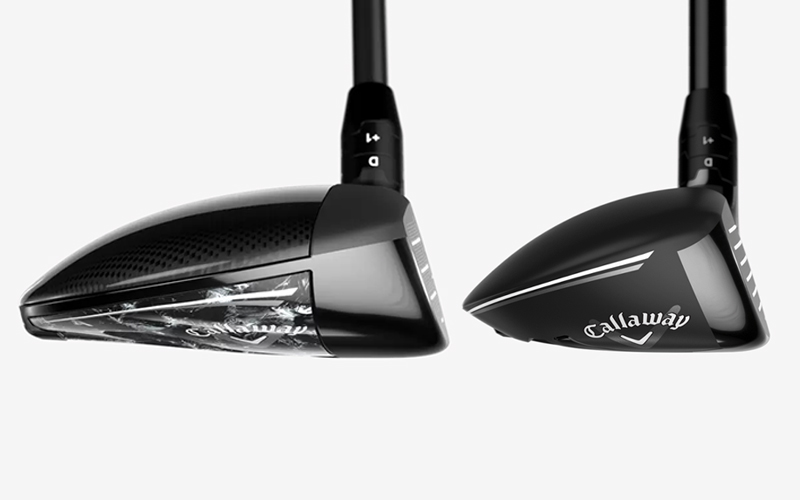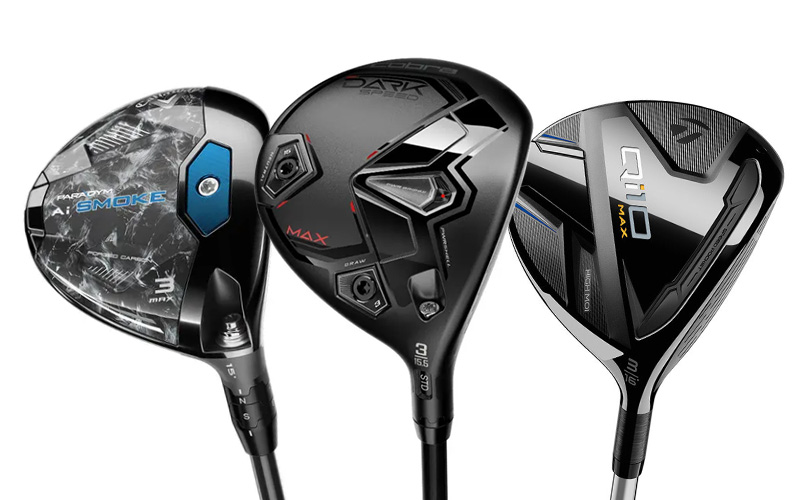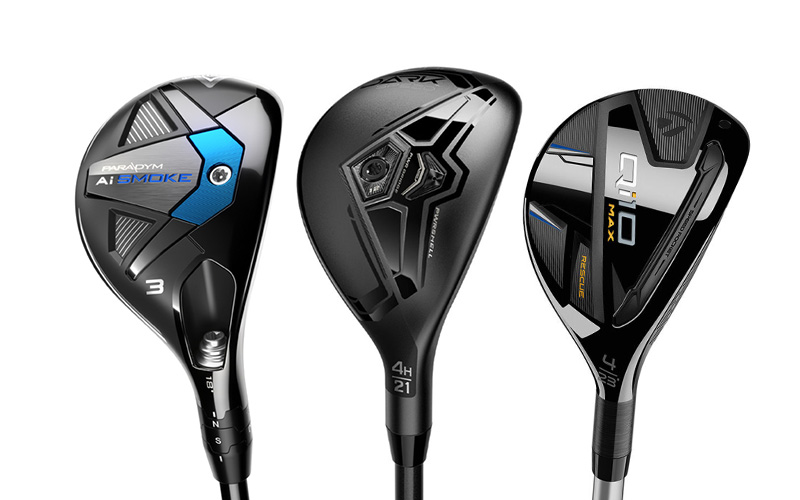Fairway Woods vs Hybrids: What’s the Best Mix For Your Bag?

Fairway woods vs hybrids: which should you carry in your golf bag? We compare their designs, performance, and best use cases, giving you clear guidance on which club combination can enhance your game.
Key Takeaways: Fairway Woods vs Hybrids
- Fairway woods are best for long, high shots from the fairway or off the tee, thanks to their larger heads and higher launch angles.
- Hybrids (sometimes referred to as ‘rescue cubs’) offer more versatility and ease of use from various lies, making them a great substitute for long irons and useful in tough course conditions.
- Choosing between fairway woods and hybrids depends on the shot scenario; fairway woods excel in distance and height, while hybrids provide control and adaptability, especially in rough conditions.
Understanding Fairway Woods and Hybrids
Fairway woods and hybrids serve distinct purposes in a golfer’s bag, often complementing each other to provide versatility. Many golfers carry a mix of both to adapt to various situations on the course. Fairway woods generally come with larger heads and longer shafts, designed to offer distance and forgiveness, particularly off the tee and from the fairway.
On the other hand, hybrid golf clubs are engineered to combine the best attributes of long irons and fairway woods. They often feature a smaller head and shorter shaft, making them easier to handle, especially from difficult lies.
Grasping the fundamental differences and similarities between these two types of clubs plays a vital role in deciding which to incorporate into your golf bag. We will delve into their design, playability, versatility, ball flight, and what’s the best mix for your golf bag.
Related article: Hybrids vs Irons
Key Differences in Design

The distinct design of fairway woods and hybrids sheds light on their specific purposes. Fairway woods have larger heads compared to hybrids, which helps increase the launch angle. This is particularly beneficial when trying to achieve maximum distance and height from the fairway or off the tee. The deeper head of a fairway wood also contributes to its ability to lift the ball high into the air.
In contrast, hybrid clubs have a more compact design with a head that resembles an iron. This design includes a larger face for forgiveness and a narrower profile, making them more effective for hitting from longer grass with a downward iron-style swing. Hybrids also typically have shorter shafts than fairway woods, which can inspire confidence in many players. For example, the shaft length of a 3 hybrid is about 40 inches, compared to 42 inches for a 5 wood.
Another significant difference lies in the center of gravity. Hybrids have their center of gravity closer to the club face, resulting in a lower launch and more rollout compared to fairway woods. This design difference can significantly impact your play, especially when dealing with various course conditions.
Pros and Cons of Fairway Woods

Fairway woods offer several advantages, including distance, and high flight, but they also come with some drawbacks. Comprehending these advantages and disadvantages can guide you in determining the effective usage of fairway woods.
Benefits of Fairway Woods
One of the main benefits of fairway woods is their distance – they are the longest clubs available in a golfers arsenal. They are not as forgiving compared to irons and hybrids, most players who struggle with a hook or slice notice it most with their fairway woods. Modern fairway woods are more forgiving than those of previous decades
Fairway woods offer several advantages on the golf course, including:
- Maximum height and distance
- Versatility for achieving long, high shots
- Reliability off the tee, allowing golfers to achieve considerable distance with accuracy
Drawbacks of Fairway Woods
Despite their many benefits, fairway woods do have some drawbacks. They can be challenging to use in rough conditions due to their larger head and extra mass. This makes it harder to cut through thick grass and achieve a clean strike, especially for players with slower swing speeds.
Additionally, fairway woods require a shallower swing path that does not hit down on the ball like you can with an iron. Some golfers struggle hitting fairway woods if they have a natural tendency to take a decent divot when striking through the ball.
Furthermore, the larger head shape of fairway woods might cause some golfers to ‘top’ the golf ball when hitting off the deck, leading to less effective shots.
Pros and Cons of Hybrids

Hybrids offer a mix of versatility and ease of use, but they also come with certain limitations. Assessing these pros and cons can assist you in making wise decisions about including hybrids in your golf bag.
Benefits of Hybrids
Hybrids are known for their versatility and ease of use, making them a popular choice among golfers of all skill levels. These clubs are designed to be easier to hit than long irons and fairway woods, providing more forgiveness on off-center hits. This makes them particularly beneficial for less experienced golfers who might struggle with consistency.
Many golfers find hybrids extremely versatile, as they perform well in a variety of situations, from the fairway to the rough. Their design allows for effective shots from different lies, making them highly adaptable clubs that can replace long irons in most golfers’ bags.
Drawbacks of Hybrids
One of the primary drawbacks of hybrids is their draw bias, which is a right to left ball flight for a right hander. This design feature is intended to help players who struggle with slicing, but it can be problematic for those who already play a draw or hook. As a result, hybrids might not be as forgiving for players with a natural draw or hook tendency. Many hybrids can be adjusted to suit your swing, custom fittings can help eliminate some of this draw bias.
Another limitation of hybrids is that they typically offer less distance compared to fairway woods. While they are easier to hit and more versatile, they may not achieve the same yardage. This trade-off between ease of use and distance is something golfers need to consider when choosing between hybrids and fairway woods.
Situational Use: When to Choose Fairway Woods or Hybrids
Choosing between fairway woods and hybrids largely depends on the situation you find yourself in on the course. Each type of club has its strengths and is better suited for specific scenarios. Knowing the right time to use each greatly contributes to improving your gameplay.
Tee Shots
Fairway woods are typically the go-to choice for tee shots, thanks to their larger heads and higher launch angles. These features make them ideal for achieving long distances off the tee, plus teeing up the ball helps many golfers with their woods.
Hybrids can also be used for tee shots, particularly on shorter par 4s when accuracy is more critical than distance. Their smaller heads offer more control and precision than a fairway wood, and more distance than a long iron. Hybrids can be the ideal club for long par 3s – for those with slower swing speeds who can’t reach the green with an iron.
Fairway and Rough
When it comes to navigating the fairway and rough, hybrids tend to be more versatile than fairway woods. Their design makes them easier to hit from tough lies, providing better performance from the rough compared to fairway woods and long irons. This makes hybrids a valuable tool for many golfers, especially when dealing with challenging course conditions, or they’re regularly exploring the boundaries of the course.
Fairway woods, with their larger heads and extra mass, can struggle in rough conditions. However, they excel on the fairway, providing the distance and high ball flight needed for long approach shots. Golfers with slower swing speeds might prefer fairway woods for these situations, as they can achieve greater distance with less effort.
Approach Shots and Long Par 3s
For approach shots and long par 3s, both hybrids and higher lofted fairway woods can be effective choices. Hybrids, with their versatility and ease of use, are often preferred for precise shots that require a high degree of control. They can be particularly useful for getting the ball onto the green from longer distances, making them a reliable option for many golfers.
A fairway wood, such as the 5 wood, is also excellent for approach shots due to its ability to produce high shots that can stick and hold to the green. This makes them ideal for long par 3s where accuracy and distance are both critical, especially when avoiding fairway bunkers.
Comparing Distances: Fairway Woods vs Hybrids
Knowing the carry distances of fairway woods and hybrids is key to making educated club selections. Comparing these distances can help golfers choose the right club for each shot, ensuring they have the appropriate tools to cover all yardages on the course.
Distance Charts
Distance charts provide valuable insights into the carry distances achievable with fairway woods and hybrids based on swing speed. It is a great idea to track your shots using a GPS App or golf rangefinder to create a personalized distance chart for yourself.
Distances you should expect from fairway woods vs hybrids vary from golfer to golfer, however, below should give you a good example of what to expect:
- 3 Wood (15°) = 200 yards
- 5 Wood (18°) = 185 yards
- 3 Hybrid (18°) = 175 yards
- 5 Hybrid (24°) = 160 yards
Fairway woods provide greater distance than hybrids with the same loft angle. By comparing these distances, golfers can optimize their club selection for better performance on the course.
Related article: Average Distance for Each Club
Shaft length and loft angles
Fairway woods typically have a shaft 2-4 inches longer than that of a hybrid. The extra reach provides increased head speed and ball speed resulting in further distances.
Typical lofts of fairway woods, hybrids and long irons:
- 3 Wood = 13°-15°
- 5 Wood = 17°-19°
- 7 Wood = 20°-22°
- 3 Hybrid = 18°-20°
- 4 Hybrid = 21°-23°
- 5 Hybrid = 24°-26°
- 6 Hybrid = 27°-30°
- 3 Iron = 20°-24°
- 4 Iron = 23°-27°
Customizing Your Golf Bag: Fairway Woods and Hybrids
Tailoring your golf bag with a balanced combination of fairway woods and hybrids can substantially improve your game. By understanding how to replace long irons and implement a gapping strategy, you can ensure that you have the appropriate clubs for every shot, covering all distances from tee to green.
Having a mix of fairway woods and hybrids helps cover more yardage gaps, ensuring a more versatile set of clubs. Amateur golfers should aim for 10-20 yards between each club in their bag to maintain consistent gapping. This approach optimizes performance by providing the right club for every distance and situation, leading to better overall play.
Replacing Long Irons
Substituting long iron clubs with hybrids or fairway woods can enhance the adaptability and tolerance of your golf bag. Long irons are notoriously difficult to hit, especially for players with lower swing speeds. The low flight of long irons makes it challenging to carry greenside hazards, which is why many golfers opt for hybrids or fairway woods instead.
A 3 hybrid, for example, with 18-20 degrees of loft, is designed to replace a 3 iron, while a 3 wood with 14-16 degrees of loft replaces a 1 iron. Hybrids are more forgiving and easier to launch than long irons, making them beneficial for a wider range of golfers.
By replacing long irons with hybrids or fairway woods, golfers can reduce the number of different clubs they need to carry, leading to a more streamlined and versatile bag.
Gapping Strategy
Adopting a gapping strategy is vital for maintaining adequate distance gaps between clubs, thus enhancing overall play. Proper gapping typically involves having around 10-15 yards between each club, preventing large yardage gaps and optimizing your golf bag setup.
Carrying clubs with overlapping yardages or ones you’re not comfortable with should be avoided. Instead, focus on ensuring each club has a distinct and useful role in your bag. This strategy helps you maintain consistent performance across all distances, allowing you to approach every shot with confidence and precision.
Summary: Fairway Woods vs Hybrids
In summary, both fairway woods and hybrids offer unique advantages and can complement each other to enhance your golf game. Fairway woods provide distance, and high flight, making them ideal for tee shots and long approach shots. However, they can be challenging in rough conditions and sometimes difficult to hit from the deck. Hybrids, on the other hand, are versatile, easier to hit, and effective from various lies, though they may have a draw bias and offer less distance compared to fairway woods.
By understanding the differences, what you hit well and how far you hit each club you can make an informed decision about what best suits you. Customizing your bag with a mix of fairway woods and hybrids (potentially replacing long irons), and implementing a gapping strategy will help you optimize your performance on the course. Ultimately, the right combination of clubs will give you the confidence and versatility needed to tackle any shot.
Frequently Asked Questions
What are the primary differences between fairway woods and hybrids?
Fairway woods have larger heads and longer shafts for higher launch angles and distance, while hybrids have smaller heads, shorter shafts, and are generally easier to hit. So, fairway woods provide more distance, while hybrids offer more control and accuracy.
When should I use a hybrid instead of a fairway wood?
You should use a hybrid instead of a fairway wood when you want a more versatile and easier club to hit. Hybrids are ideal for tough lies in the rough, as well as for approach shots and long par 3s. They offer better precision and control.
What are the benefits of using fairway woods off the tee?
Using fairway woods off the tee can provide both distance and accuracy, thanks to their larger heads and higher launch angles they give you long distances. From the tee box, you can tee up your ball which helps most golfers with their fairway woods.
How do I decide which clubs to include in my golf bag?
You should include a mix of fairway woods and hybrids in your golf bag to cover different yardage gaps and ensure proper club spacing. Try to have 10-15 yards between each club and consider replacing long irons with hybrids or fairway woods for better versatility and forgiveness.
What is the importance of a gapping strategy in golf?
A gapping strategy in golf is important to ensure consistent performance across all distances, preventing large yardage gaps and optimizing your golf bag setup. It helps you approach every shot with confidence and precision.
